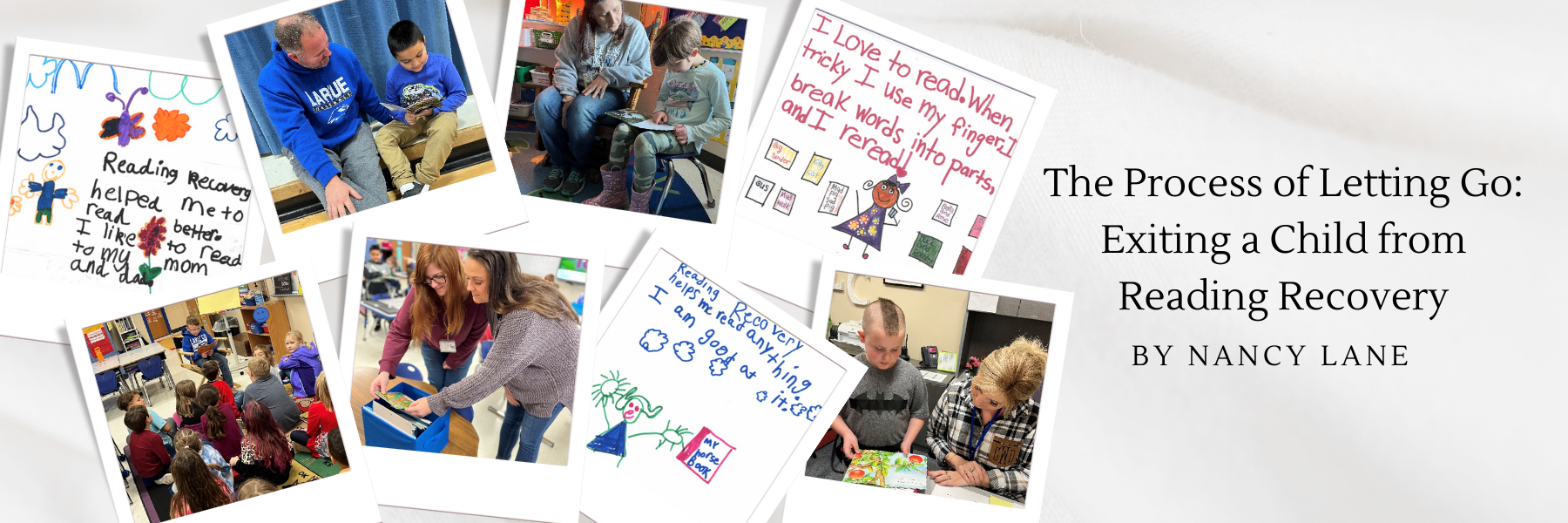BLOG
The Process of Letting Go: Exiting a Child from Reading Recovery
By Nancy Lane
We all have that feeling as our time with a child draws to an end. The feeling starts in the pit of our stomachs and ends in our hearts as we prepare to exit a child from Reading Recovery. Will he or she remember the encouragement, the love, and the prompts we have given them during our time together? Will he or she sustain the gains that have been made and continue to grow as a literacy learner? How can one know and have the confidence needed to not have that gnawing feeling as the other teacher administers the Observation Survey? Clay tells us that there can be no hard and fast criteria. (LLDI, 186) and devotes a whole chapter to the topic, giving us in-depth direction on how to prepare for this transition.
The process starts well before inviting the visiting/testing teacher over to assess the child. In my practice, I find that several steps are important to have in place to ensure that this process is seamless. It begins with a thorough check on Clay’s words in Chapter 7 of LLDI and having a planned approach beginning about four weeks prior to the end of lessons. During these four weeks, a Reading Recovery teacher should work alongside the child in the classroom taking note that the child is comfortable using his or her competencies there. I have had multiple teachers express dismay that they do not have extra time to complete these classroom visits. I convey that this visit can happen in place of the child’s lesson for the day, ensuring time will be available as it is such a valuable piece of the exiting process. I also encourage teachers to be adaptive in these last lessons. For example, if more polishing is needed in writing, spend more time writing with the child or if a child needs to be more fluent then devote more time to familiar reading during the lesson.
Also, when considering a child’s successful exit from lessons, a thorough check on the child’s current competencies is in order. Clay tells us that a child “who is nearing the end of his lesson series should be able to
- monitor his own reading and writing
- anticipate a possible syntactic structure
- search for different kinds of information in word sequences, in meaning and in sound-letter sequences
- discover new things for himself
- cross-check one source of information with another
- repeat as if to confirm his reading or writing so far
- use all sources of information together on the first attempt
- self-correct taking the initiative for making decisions or getting words right in every respect, and
- solve new words by these means” (LLDI 187)
Is this enough information to know about the child before we cease lessons? Not quite. One must also contemplate what the child cannot yet do. Checking for patterns in your lesson records and running records are helpful as well as discussions with his or her classroom teacher. These discussions can be very enlightening when things like guided reading levels and how the child helps himself when completing independent work are discussed. Doing this during this four-week time frame before the end of lessons gives us enough time to rectify any issues. Discussions with the child’s parents are important as well. Letting them know that the time is coming to an end can help prepare them to be more vigilant about monitoring the child’s progress in the classroom, with homework, and with reading in general. I also encourage teachers to ask for student work samples to see how the child is performing academically in multiple subject areas.
If a teacher finds that all the information is favorable for the child, he or she will review this knowledge in a systematic way and record it on the Recommendations for Discontinuing the Lesson Series to share with the child’s teacher and/or school team before inviting a fellow Reading Recovery teacher to complete the Observation Survey.
I have seen many children become vastly uncomfortable when asked to read to someone besides their Reading Recovery teacher. To prepare the child for reading with someone besides you, I allow the child to read a favorite book to a Kindergarten class or teacher, the principal, the school secretary, the lunch lady, the PE teacher, etc. multiple times throughout the lesson series to help acclimate the child to this activity.
What happens if the results of the Observation Survey produce unexpected results? Clay prepares us for these moments when the child shows that he or she needs further help in areas that are weak. In situations such as this, a Reading Recovery teacher should speak with his or her Reading Recovery Teacher Leader to possibly provide short-term, additional time with this child, making new plans, and then assessing only the critical areas on this second occasion.
At times, despite superb instruction, a child will need additional specialist help and a referral for further long-term support is necessary. This transfer to a new support system can be a lengthy process, but it is imperative for it to begin as soon as possible, whether it be small group literacy instruction or a special education placement.
Clay reminds us that both scenarios, the successful designation of exiting with Accelerated Progress/Progressed of the child as well as the child that is referred for further services, are positive outcomes. Without the intervention, the child in both situations would be left behind their peers without the support of a self-extending system or a system in place for further long-term support. (LLDI, 19).
After exiting, follow-up and ongoing monitoring of our students are necessary. Follow-up studies of Reading Recovery children show that in general, progress is sustained for most but that some children remain at risk, easily thrown by life circumstances or by subsequent learning experiences of poor quality (LLDI, 193).
We have to remember that Reading Recovery is a short-term intervention that lasts from about 12-20 weeks. During this time, it is natural that we form many bonds with our students. They learn to first trust us and then themselves, as they decode and learn to be readers and writers. As much as we would love to hang on to these children we have nurtured, grown to love, and witnessed great progress, our expertise is needed with many more children.
I recently stumbled on a quote from Malala Yousafzai who was awarded the Nobel Peace Prize for her fight for every child to receive an education. She said, “One child, one teacher, one book, one pen can change the world.” Dear reader, never forget that you truly are changing the world, one child at a time. Your work is not easy. It can be tiresome and discouraging but oh, so rewarding. Remain steadfast. The world will be a better place because of your investment in one child at a time.

Nancy Lane has worked as an educator in the lower primary grades for a total of 25 years. She has been involved in the Reading Recovery community for a total of 17 years, 12 years as a Reading Recovery Teacher and the last five as a Reading Recovery Teacher Leader at the LaRue County Reading Recovery Site in Hodgenville, Kentucky. Nancy is also a National Board Certified Teacher in the area of Literacy: Reading-Language Arts/ Early and Middle Childhood. In her free time, she enjoys spending time with her family, which includes her husband, their two children, and three rowdy dogs.
THE JOURNAL OF READING RECOVERY
Spring 2025
OPEN ACCESS: Centering Children and Working Towards Equity: Teaching All Children to Read by Catherine Compton-Lilly
Literacy Leadership in Support of Equity: Whatever It Takes by Allison Briceño
Exploring the Purposes, Power, and Potential of Familiar Reading by Jamie Lipp
Full Circle: From Student to Psychologist by Joyce Romano







